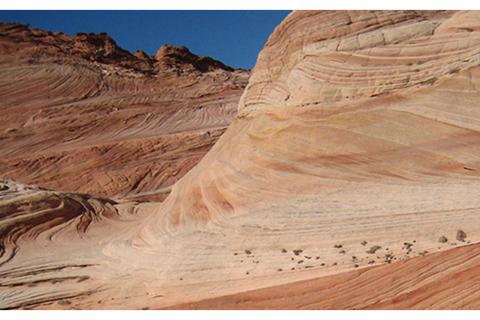
Geology is all about the outdoors and travel. It's the foundation of our most prized camping sites, like Yosemite's domes and Moab's arches, as well as the hills and flatlands we zip by on the way to our favorite destinations.
So if life is about the journey as much as the destination, a little geological curiosity can make any drive or camping spot a lot more interesting. Here are a few places to explore. But be forewarned, once you start noticing them, the view from your car window might never be the same.
1. Highways across the United States cut through a colorful geologic storybook: volcanic explosions, mass extinctions, tectonic shifts, vast inland seas and floods of epic proportions. Look at the layers and find coal from ancient swamps, volcanic ash from eruptions, fossils from extinct animals, mud mixed with rounded river rocks from floods, and cracks from fault lines, just to name a few.
2. Much of the United States has been covered at some point in time with a shallow sea, which formed a calcium carbonate limestone, rich with all sorts of plant and animal fossils. These limestone formations range in color from black to tan, and can be found from Florida, through most of the Midwest, Texas and the Rockies. This limestone is also prone to eroding into intricate cave systems, decorated with crystals, stalactites and stalagmites, such as the Meramec Caverns in Missouri and Carlsbad Caverns in New Mexico.
3. Volcanic landscapes across the country tell a story of super volcanoes, extinctions and even the creation of new land. The deposits come in many forms, but some of the most visually striking are the ancient river-like flows of black basalt that wind prominently through Idaho, Washington and Oregon, and also cap peaks all the way to the Blue Ridge Mountains. In some areas basalts cools into bizarre and stunning polygonal columns, such as Devil's Tower in Wyoming.
4. Glaciers scoured the North and the high peaks, leaving behind stunning scenery and tens of thousands of lakes for a canoeing and fishing paradise. They also left behind moraines, or long hills of rock and dirt at their final edges, and striations, or scratches, carved into the bedrock from the moving mass of ice. These are so widespread, there are even striations in Central Park and moraines in Long Island. Actually, the ice sheets created what we now know as the Manhattan area. Imagine the landscape under millions of tons of ice, and a sea level 200 feet lower.
If you want to get your mind, and fingers, deeper into the rocks, pick up a roadside geology guidebook, which is published for every state, a geology magnifying loupe, a rock hammer and get out there.
- 965 views

